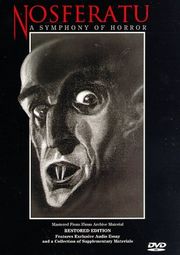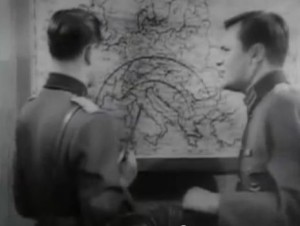With respects to Richard O’Brien this is not a science-fiction double feature, but a main feature and a short one.
Sunday night my sweetie-wife and I settled in after dinner to watched a silent horror film. I had recently developed a hankering to watch ‘Nosferatu’ again and my sweetie indicated that she too would re-watched this classic of early German Cinema.
 Nosferatu made in 1922 is an early vampire movie and in the good tradition of vampire movies, lifted heavily from the classic novel Dracula. Unfortunately for the producers and the studio, Dracula was still under copyright in 1922 and they were sues for infringement. They lost the suit and a judicial order instructed them to destroy all copies of the film. Lucky for future film fans they were less than successful and the movie survived. The edition on Netflix is a restored version using source material from around the world attempting to recreate the original print.
Nosferatu made in 1922 is an early vampire movie and in the good tradition of vampire movies, lifted heavily from the classic novel Dracula. Unfortunately for the producers and the studio, Dracula was still under copyright in 1922 and they were sues for infringement. They lost the suit and a judicial order instructed them to destroy all copies of the film. Lucky for future film fans they were less than successful and the movie survived. The edition on Netflix is a restored version using source material from around the world attempting to recreate the original print.
If you are familiar with Dracula then if very broad stroke you are familiar with the plot of this film. A real estate agent is dispatched to the mountains beyond the forest to secure a transaction for a mysterious nobleman who is buying a building in a bustling metropolitan center. The estate agent endures horrors at the hands of his host and is nearly killed. The nobleman, a vampire, secure transport by sea, kills the crew enroute, because the undead have no concerns about travel safety, and arrives to begin spreading his deadly plague in his new home. The estate agent makes it home and the search begins to discover what is happening.
Unlike Dracula, in Nosferatu the vampire ‘s attack is not transformative and the victims remain dead. Where Dracula kept a tight scope on the action, dealing with a hand full of characters, Count Orlok is killing dozens and the entire city is threatened by the supernatural danger.
This film, while occasionally hampered by it distance from us in time, it is nearly a century old, still holds up and many considerable way. There are many interesting twists and hints of German Expressionism throughout the production. If you have an interest in film history and silent movies, this is worth the time.
Later, by myself, I watched a WWII training film ‘Resisting Enemy Interrogation.’
 Produced during the war, I happened to catch the ending of this film on TV once. Now through the wonders of YouTube and that fact that all government films are public domain, I have finally taken the time to watch the entire movie.
Produced during the war, I happened to catch the ending of this film on TV once. Now through the wonders of YouTube and that fact that all government films are public domain, I have finally taken the time to watch the entire movie.
The film is the story of 5 American airman, the crew of a ‘B-99’ (no such plane in WWII) that have crashed and are now prisoners. The crew have destroyed the aircraft and are determined not to talk. They will not provide the enemy with any useful intelligence. Their German captors, suspecting a major raid is about to occur, are racing the clock in trying to break the crew and glean the vital information. The German do not resort to torture and brutality, but cunning and classic interrogation techniques. Despite their best intentions the crew, one by one, fall prey to the tricks and in the give away the target of the next days raid, even though not one man among the crew know that.
This is a particularly well made training film, with a fairly tight narrative arc. A couple of the actors went on to have quite successful careers. The biggest fault in the film, and the one that made me so interested in seeing it, is that the German are by definition the protagonists. The Germans have an active goal, discover the details of the coming raid, the German have the obstacles, the airmen who will not cooperate, and it is the German’s racing the clock against failure. When the German’s unlock all the secrets it is the climax of the story. While during the war it would have been difficult to feel sympathy for the enemy as they raced a clock, now with 70 some odd years separating us, it almost feels like you want cheer them on as they prove their cleverness.
Almost.
